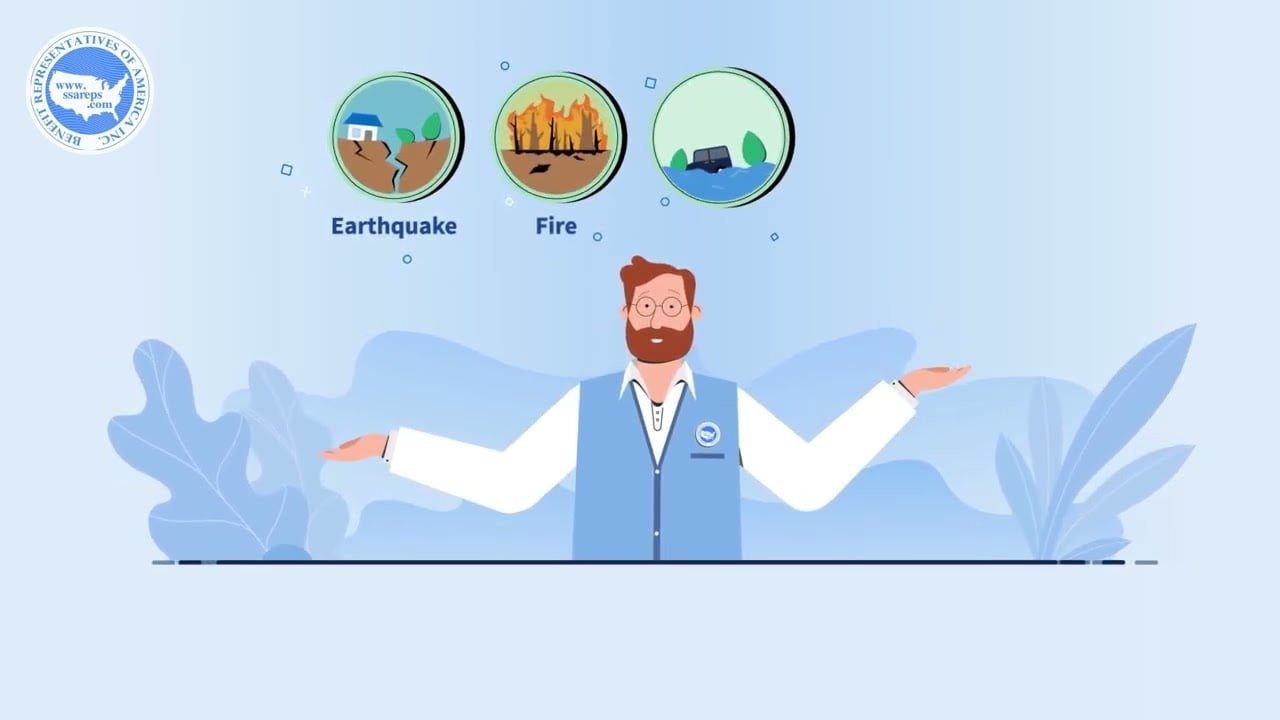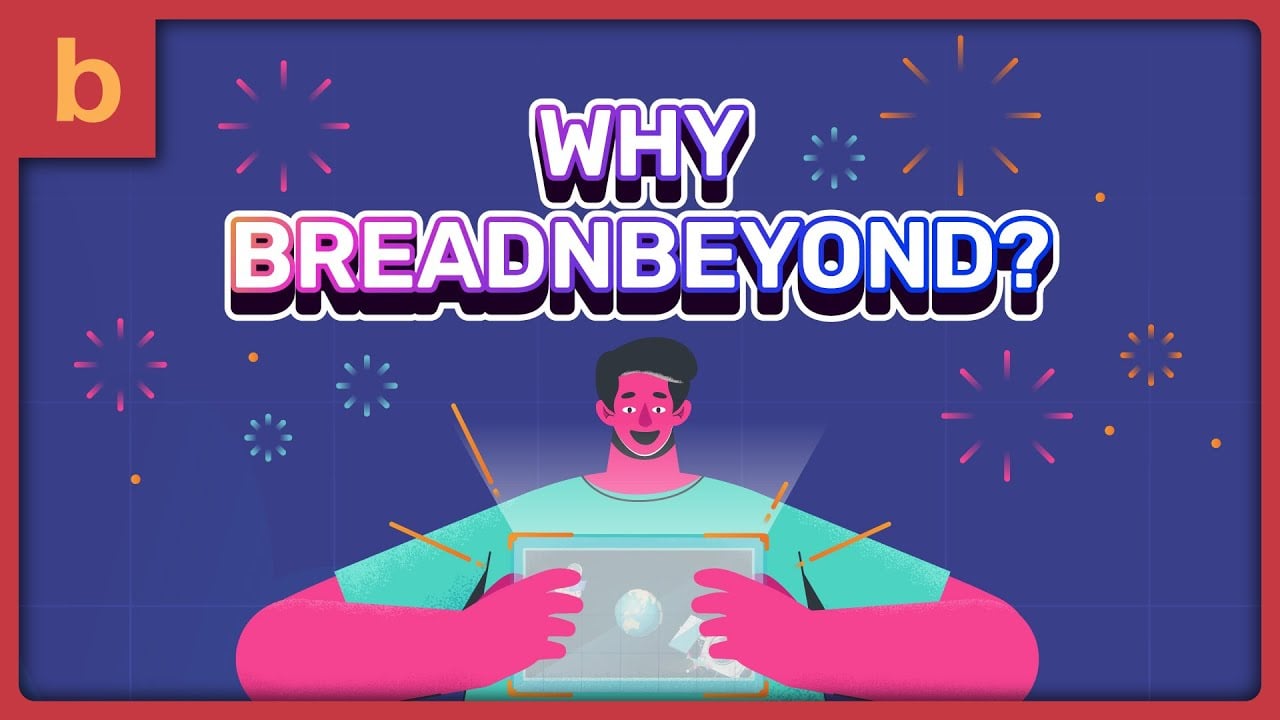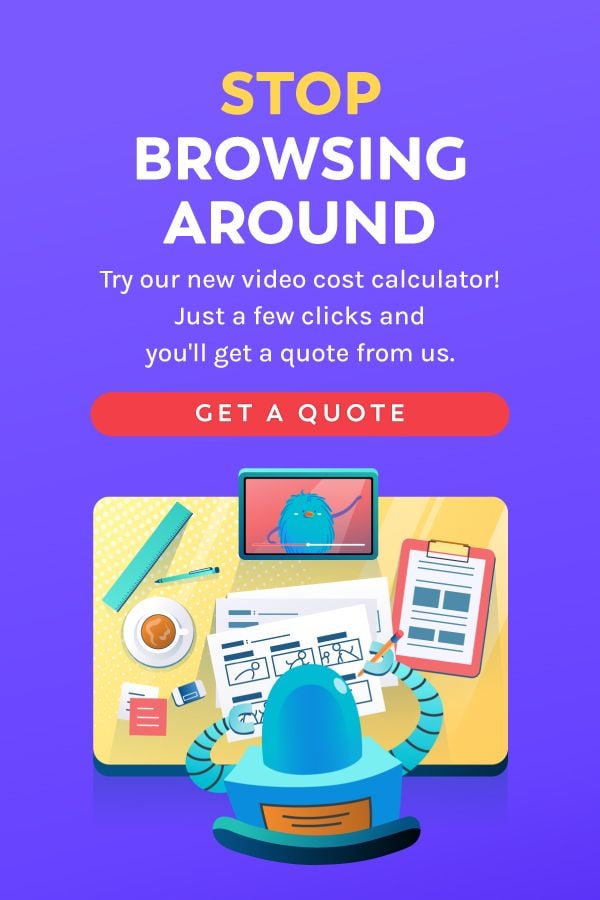Table of Contents ×
- 1 Our Previous Study About The “Ideal” Explainer Video Length
- 2 Are Longer or Shorter Videos Better?
- 3 How to Find Your Ideal Explainer Video Duration?
- 4 How to Decide the Best Length for Your Explainer Videos?
- 5 How Long Is Too Long for a Video?
- 6 Does the Platform Matter When Choosing Your Explainer Video Length?
- 7 Wrapping Up: Less is More?
When choosing your explainer video length, focus on two things: message complexity and audience attention. Go with 30 seconds for teasers and quick intros, 60 seconds for a more balanced story, and 90+ seconds for deeper explanations.
In most cases, businesses go with a 60-second video. It gives you just enough time to highlight the value, tell a mini story, and drive action, without losing your viewers halfway through.
Our Previous Study About The “Ideal” Explainer Video Length
Our earlier study found that most viewers start dropping off around the two-minute mark. You can check out the details here: How Many Words Do 1-Minute Explainer Videos Have?
But that was almost 10 years ago. Long before the era of TikTok marketing, the rise of Instagram Reels, and back when YouTube still had 240p thumbnails and annotation spam.
The video landscape has shifted dramatically since then. Attention spans have shortened, but paradoxically, binge-watching and long-form content have also flourished.
So relying solely on outdated benchmarks like “X is the best video length” doesn’t cut it anymore.
Your product, audience, and goals are unique. That’s exactly why I’m writing this updated guide, not to hand you a fixed rule, but to help you figure out what actually works for your message.
I’ll share some of my go-to strategies and insights from working with a wide range of businesses on explainer videos, and hopefully help you land on a duration that makes sense, not just what the internet says is “optimal.”
Are Longer or Shorter Videos Better?
Short-form videos are usually better, but not always. Long-form videos can work if you can make every second count.
A short video (think 30–45 seconds) needs you to focus on what truly matters: the problem, your solution, and a clear next step.
That said, longer marketing videos (90 seconds or more) still have a place, especially if your product features need a bit more context to make sense.
Here’s an example. I’m choosing two explainer videos with different lengths, but still within the same industry, targeting the same audience, and with the same intent: to introduce a solution in the healthcare space.
We created this 30-second explainer video for PrescriberPoint.
In under a minute, the video delivers a fast, benefit-focused message: here’s what PrescriberPoint is, here’s how it saves time, and here’s why it matters to busy doctors.
It’s tailored for top-of-funnel viewers who need a clear “why should I care” moment, not a full walkthrough. Stretching it to 90 seconds would’ve diluted the impact and risked losing attention before the hook landed.
And let’s see this 2-minute explainer video from Scribekick, which dives into a more nuanced, trust-driven message; explaining how their remote medical scribe service works, why it matters, and how it fits into a healthcare provider’s daily workflow.
In this case, the longer duration allows space to build credibility, walk through multiple pain points, and guide the viewer through a solution that isn’t immediately intuitive. Trimming it down to 30 seconds would’ve stripped away the depth and trust needed to convert.
So, no matter what the video types are, the key elements here are clarity and engagement.
Even a 3-minute video that’s well-paced, visually interesting, and easy to follow will always beat a 30-second one that’s rushed and confusing.

How to Find Your Ideal Explainer Video Duration?
The best video length depends on your message, your audience, and your goal. Most explainer videos fall into three common timeframes: 30 seconds, 60 seconds, or 90 seconds. Each has its own strengths and sweet spots.
Once you understand what each duration does best, it gets a whole lot easier to choose.
What can you actually say in 30-second videos?
A 30-second explainer video is ideal when you need to grab attention quickly and make a memorable first impression. It works especially well for brand awareness campaigns, short video ads, product teasers, or homepage intros where viewers are just getting to know you.
This is an example of a 30-second explainer video we created for Aria Protocol, an intellectual property platform:
Since the service was to introduce a completely new way of managing and protecting digital ownership, the goal was to spark curiosity, increase viewer retention, and not explain everything in detail.
We focused on delivering a sharp, punchy message that highlighted the problem (IP confusion), hinted at the solution (a decentralized system), and invited viewers to learn more on our website. All in under half a minute.
Because of its brevity, it’s perfect for top-of-funnel content, quick product teasers, or brand awareness campaigns.
It’s also a go-to video duration for mobile-first platforms like TikTok, Instagram Reels, and YouTube Shorts, where users are scrolling fast and expect instant value.
You don’t have time to go deep, but you do have time to grab attention, spark curiosity, and leave your audience wanting more.
Here’s what typically fits in 30 seconds:
- A quick hook or problem statement
- A high-level overview of your solution
- One strong visual or metaphor to anchor the message
- A light call-to-action
What doesn’t fit? Long feature lists, background stories, or layered explanations. Trying to squeeze in too much can make it feel rushed or confusing.
When should you go for a 60-second explainer?
Go for 60 seconds when you need just enough time to tell a brand story, without losing your audience halfway through.
If your goal is to provide educational content that engages and converts (all in one go), 60 seconds gives you the storytelling space to do that. Not too short, not too long.
A 60-second explainer video is the most common duration in many of our projects. I think most clients go for this length because it feels just right.
Not too rushed, but also not dragging things out.
It strikes that perfect balance between delivering enough detail and keeping the viewer’s attention.
This format is ideal when your message is more than a teaser but doesn’t require a full deep dive. It gives you just enough time to walk your audience through a mini journey (one that identifies a problem, introduces your solution, highlights key benefits, and wraps up with a compelling call-to-action) all without testing their patience.
60-second explainer videos work especially well for:
- Product or service overviews
- Startup pitches
- SaaS platforms
- Mobile app walkthroughs, or
- Any offering where your audience needs context to understand value, but not a full tutorial.
You can show how it works, who it’s for, and why it matters, all within a single, digestible minute.
We crafted a 60-second animated explainer video for Benefits Representatives of America Inc. to raise awareness about PTSD and explain how they support individuals affected by it.
One minute was the perfect length because it strikes the right balance between emotional storytelling and clear information, so the message was impactful while still respectful of the viewer’s time and attention span.
Are 90-second videos too long?
90-second videos are not that long if you use the time wisely. While 90 seconds may sound like a long time commitment in internet time, it can be exactly what you need when your message is a bit more complex, or your audience is already invested.
This duration gives you the breathing room to fully explain how something works, walk through multiple features, or build a stronger emotional connection through storytelling.
90 seconds is the ideal duration for more in-depth educational videos from B2B, SaaS, or technical products where viewers need a bit more context to really “get it.”
Suppose you’re introducing a new platform, showcasing multiple use cases, or addressing pain points for different personas. In that case, 90 seconds provides a space to elaborate without resorting to rapid-fire narration or overcrowded visuals.
That said, longer videos come with one big caveat: you need to earn your viewers’ attention every second of the way.
In our own explainer video “Why Breadnbeyond?”, we wanted to do more than just say we make explainer videos. We wanted to demonstrate why we do it, how we help businesses communicate more effectively, and what sets us apart in a crowded market.
That’s why we went with 90-second video formats.
It gave us room to blend storytelling, visuals, and proof points in a way that felt authentic and persuasive without rushing or overwhelming viewers. Engagement tends to drop the longer a video runs, so pacing, storytelling, and visuals need to stay tight and purposeful.
So no, 90 seconds isn’t “too long”. It’s just more of a time commitment, both for you and your target audience.
How to Decide the Best Length for Your Explainer Videos?
The best length is the one that tells your story clearly without wasting a single second. So it all depends on your message, target audience, platform trends, and goal.
If you’re running a social media ad or trying to catch eyeballs quickly, a 30-second video might be all you need.
If you’re looking to give viewers a fuller understanding of your product or service, 60 seconds usually hits the sweet spot.
And if you need to break down a complex idea, showcase multiple features, or build trust in a more thoughtful way, 90 seconds can be a great choice.
Here’s a quick way to think about it:
- 30 seconds = best for short video ads that need to grab attention and tease a solution
- 60 seconds = best for balanced storytelling and conversions; you can create educational videos while encouraging viewers to take action.
- 90 seconds = best for educational videos that take deeper dives and explain more complex ideas
- 2 minutes and more = best for product demos, training/tutorials, or brand stories where your audience is already familiar with you and looking for detailed information.
Rather than chasing a specific duration, focus on telling a concise, compelling story. Start with a strong hook, explain the problem, present your solution, and end with a clear call-to-action.
Once you’ve mapped that out, the right length will often reveal itself naturally.
I made this practical comparison table for 30, 60, and 90-second explainer videos:
| Duration | Best For | Pros | Cons | Ideal Use Cases |
| 30 seconds | Quick impressions, social media, pre-roll ads | – Grabs attention fast
– Easy to share – Works on any platform |
– Limited depth
– Only room for one core message |
TikTok, Instagram Reels, YouTube Ads, teaser intros |
| 60 seconds | Balanced storytelling + action | – Enough time for problem–solution–CTA
– Engaging & to-the-point |
– Needs tighter scripting
– Not enough time for complex concepts |
Website homepage, landing pages, LinkedIn, email campaigns |
| 90 seconds | In-depth explanation, complex ideas, product walkthroughs | – Great for storytelling
– Can explore more features or use cases |
– Risk of drop-off
– Needs strong pacing to keep attention |
SaaS demos, investor pitches, YouTube organic, onboarding |
If 30–90 seconds feels too much of a pigeonhole or limiting, here’s a comparison table based on your video goals, audience behavior, and message clarity.
After all, the right duration depends more on why you’re making the video than on hitting a specific runtime.
| Video Goal | Target Audience & Behavior | Recommended Duration | Why It Works |
| Grab Attention (Top of Funnel) | Busy scrollers, low commitment, short attention span | 15–30 seconds | Quick and punchy; perfect for social media and paid ads to spark curiosity. |
| Explain a Simple Product | Time-conscious viewers, decision-ready | 30–60 seconds | Enough time to show value without losing focus or momentum. |
| Educate or Build Trust | Curious or skeptical audience, researching options | 60–90 seconds | Allows for storytelling, examples, and clarity—builds credibility and context. |
| Onboarding / Internal Training | Engaged users or team members with the intent to learn | 90–120 seconds | Viewers expect more depth and are willing to stay longer for valuable content. |
| Demo / Walkthrough | Problem-aware users who want to understand functionality | 60–120 seconds | Explains steps clearly while keeping pace; helps reduce confusion or friction. |
How Long Is Too Long for a Video?
A video is too long when it says more than your audience needs to hear to take the next step. There’s no universal cutoff. What feels “too long” depends on your viewer’s intent, how complex your message is, and where the video appears in your funnel.
A two-minute video might feel just right during onboarding, but painfully slow in a social feed.
Here are signs that your video is too long (and how to notice them):
- High Drop-Off Rate in Analytics: Check your video analytics. If viewers are consistently leaving before the halfway mark, it’s a sign the video isn’t holding their attention.
- Repetition Without Added Value. If you find yourself saying the same thing in different ways or padding the script to fill time, it’s probably too long.
- Delayed Call-to-Action (CTA): Your main message or CTA should show up early enough to catch even short attention spans. If it doesn’t appear until the last 10 seconds, you’ve likely waited too long.
- You’re Explaining What Doesn’t Need Explaining: If you’re walking viewers through something obvious or self-explanatory, that content might be better left out.
- Low Engagement on Long-Form Cuts Compared to Shorter Versions: Run A/B tests. If your shorter video outperforms your longer one in watch time and conversion rate, that’s your data talking.

Does the Platform Matter When Choosing Your Explainer Video Length?
Absolutely. Choosing the right platform for video display does matter. Different channels have different platform trends, audience behaviors, technical limitations, and content styles. A video that performs well on your website might fall flat on TikTok– the social media giant, and vice versa.
Where your explainer video will be seen should directly influence its duration. For example, social media platforms like TikTok, Instagram Reels, and YouTube Shorts favor super short, high-impact videos, usually under 60 seconds, often closer to 15–30 seconds.
These platforms are designed for quick consumption, so your explainer needs to hook viewers instantly and deliver value fast.
On the other hand, your website is where you have a bit more room to breathe.
Visitors here are likely already curious and willing to spend an extra 60 to 90 seconds to understand what you do. This makes it the perfect place for a fuller, more informative explainer video that walks through your offering and drives action.
If you’re creating an explainer for email campaigns, shorter is usually better. Think 30 to 60 seconds. Your goal is to spark interest and get the viewer to click through, not explain everything all at once.
YouTube is more flexible. While shorter pre-roll ads need to make their point fast (often within 6–15 seconds), organic YouTube content can go longer, especially if your audience behavior is actively searching for solutions. In these cases, even a 90-second or 2-minute explainer can hold attention if it’s relevant and well-crafted.
Here’s a quick and clear table summarizing ideal explainer video lengths by platform:
| Platform | Ideal Length | Why It Works |
| Instagram Reels / TikTok / YouTube Shorts | 15–30 seconds | Fast-paced, scroll-heavy platforms favor short, attention-grabbing content. |
| Facebook / LinkedIn | 30–60 seconds | Viewers expect slightly more context—ideal for awareness and quick intros. |
| Website Landing Page | 60–90 seconds | Visitors are more engaged and willing to watch a complete, informative story. |
| Email Campaigns | 30–60 seconds | Keeps load time low while delivering a strong teaser or CTA. |
| YouTube (Organic Content) | 60–120 seconds | Viewers often search with intent, so they’re more open to in-depth explanations. |
| YouTube (Ads / Pre-roll) | 6–15 seconds (skippable) | You have to hook fast and deliver the key message before the skip button appears. |
I also have asked marketing professionals and video experts to share their go-to channels and platforms for their explainer videos in this roundup: Where to Put Your Explainer Videos That Drive The Best Results?
Wrapping Up: Less is More?
The sweet spot depends on how much context your viewers need and how invested they already are.
My go-to move, both for my own videos and for clients who aren’t sure about the ideal explainer video length, is to run A/B tests and lean on real audience feedback from video analytics.
I typically create both short-form and long-form video versions of the same video, then I track which one keeps viewers watching longer and drives more engaged viewers and conversions.
Ready to hit your sweet spot? We’re here to help!
At Breadnbeyond, we’ve helped thousands of brands find that balance by combining storytelling, strategy, and animation to create videos that not only explain but convert.
Try our explainer video pricing calculator to get a better idea of how much you need to budget.








